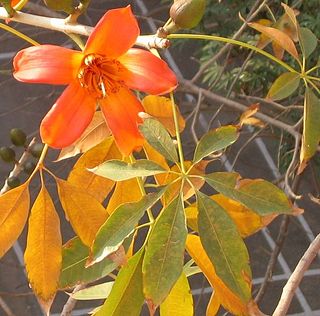
Bombax is a genus of mainly tropical trees in the mallow family. They are native to western Africa, the Indian subcontinent, Southeast Asia, and the subtropical regions of East Asia and northern Australia. It is distinguished from the genus Ceiba, which has whiter flowers.
Kapok tree can refer to several plants with seeds that grow long hairs:

Grevillea longistyla is a large shrub of the family Proteaceae that is native to south-east Queensland in Australia. It has orange to red flowers; long, narrow leaves and grows to 3 to 4 metres in height and 2 to 3 metres in width.
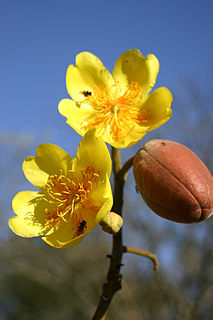
Cochlospermum is a genus of trees in the Bixaceae family; some classifications place this genus in the family Cochlospermaceae. It is native to tropical regions of the world, particularly Latin America, Africa, the Indian Subcontinent, and Australia.
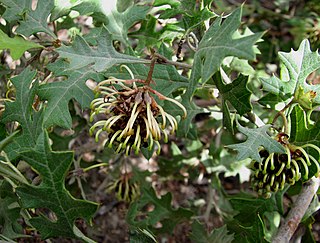
Grevillea dryophylla, also known as Goldfields grevillea, is a spreading shrub which is endemic to Victoria, Australia. It grows to between 0.3 and 1.5 metres in height. The flowers are green and light brown, maroon or dull-yellow and appear between August and November in its native range.
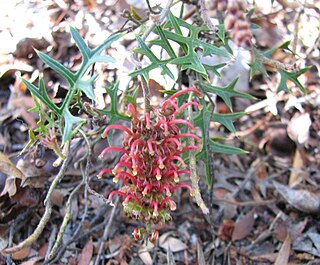
Grevillea microstegia, the Mount Cassell grevillea, is a spreading shrub which is endemic to the Grampians National Park in Victoria, Australia. It grows to between 0.3 and 1 metre in height and 2 to 4 metres in width. The flowers are reddish-brown and have green-tipped red styles. These appear between November and December in its native range.
Banksia gardneri var. gardneri is a variety of Banksia gardneri. As an autonym, it is defined as encompassing the type material of the species. It is native to the Southwest Botanical Province of Western Australia.

Grevillea gariwerdensis is a species of the plant genus Grevillea. It is endemic to Victoria in Australia. The species grows as a low, suckering shrub, between 0.3 and 1 metre in height. Flowers usually appear between October and January in its native range. These have perianths and styles which are white to pink. It is very similar in appearance to both Grevillea micrantha and Grevillea parviflora. The name Grevillea linearifolia has been misapplied to this species in the past.

Grevillea alpivaga, also known as buffalo grevillea, is a species of the plant genus Grevillea. It is endemic to Victoria in Australia. The species grows as an erect to prostrate shrub, between 0.3 and 1 metre in height. Flowers usually appear between October and February in its native range. These have pale green, white or cream perianths and styles which are white to pale pink, becoming red.

Grevillea rivularis, the Carrington Falls grevillea, is a shrub species which is endemic to New South Wales, Australia.

Grevillea dimorpha, the flame grevillea, is a species in the plant genus Grevillea. It is endemic to Victoria in Australia. The species grows to between 0.4 and 3 metres in height. Flowers usually appear between August and December in its native range. These have red perianths and styles.

Grevillea parvula , commonly known as Genoa grevillea, is a species of the plant genus Grevillea. It is native to the states of Victoria and New South Wales in Australia.
Grevillea micrantha, also known as small-flower grevillea, is a shrub that is endemic to the state of Victoria in Australia. It grows to between 0.3 and 0.6 metres in height and has narrow leaves that are 1 to 4 cm in length and 0.6 to 1 mm in width. The white or pale pink flowers appear between August and January in the species' native range.
Grevillea brevifolia, commonly known as Cobberas grevillea, is a species of the plant genus Grevillea. It is native to the states of Victoria and New South Wales in Australia. The red flowers appear between November and December in the species' native range. The species was first formally described by Victorian Government Botanist Ferdinand von Mueller in 1879 in Flora Australiensis, based on a collection from Mount Tambo in Victoria. The former subspecies G. brevifolia subsp. polychroma was elevated to species status as Grevillea polychroma in 2005. Grevillea brevifolia is listed as "Rare in Victoria" in the Department of Environment and Primary Industries' Advisory List of Rare Or Threatened Plants In Victoria. The species occurs in sub-alpine areas including the Pilot Wilderness, the Cobberas-Tingaringy Unit of the Alpine National Park, and Mount Seldom Seen.

Grevillea asteriscosa, commonly known as star-leaf grevillea, is a shrub which is endemic to the south-west region of Western Australia. It grows to between 0.3 and 2.6 metres in height. The red flowers usually appear from July to November in the species' native range.
Cochlospermum angolense is a tree in the family Bixaceae. It is native to Angola and the Democratic Republic of the Congo. An extract of the tree's bark, called Borotutu in African traditional medicine, has been studied in mice for its potential to treat malaria.

Cochlospermum fraseri is a tree in the family Bixaceae with common names cotton tree, kapok bush, and kapok tree. It is native to north western Australia.
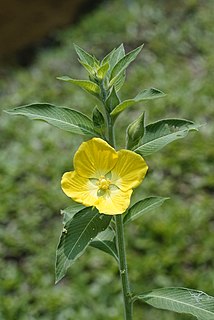
Ludwigia peruviana, with the common names Peruvian primrose-willow or Peruvian water primrose, is an aquatic, sometimes deciduous species of flowering plant in the evening primrose family. It can grow to approximately 12 feet (3.7 m) in height. While native to Peru, it has been introduced in many other countries for its attractive simple yellow flowers, it is now a common weed in swampy areas around the world.

Grevillea decora is a shrub of the genus Grevillea native to an area in the Great Dividing Range of Queensland.
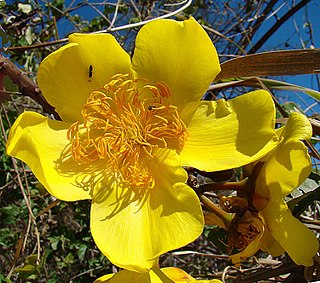
Cochlospermum vitifolium is a tree in the family Bixaceae. It is native to the Americas: from Mexico to Brazil.















